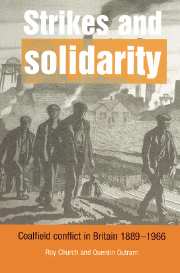Book contents
- Frontmatter
- Contents
- List of figures and tables
- Preface
- List of abbreviations
- 1 Interpreting coalfield conflict: focus and formulations
- 2 Tradition and modernity: the mining industry 1889–1940
- 3 Employers and workers: organizations and strategies
- 4 Employers and workers: ideologies, attitudes and political orientations
- 5 Configurations of strike activity
- 6 Strike participation and solidarity before 1912
- 7 Strikes, organization and consciousness in 1912 and after
- 8 Conflictual context? The ‘isolated mass’ revisited
- 9 Mining and modernity: size, sectionalism and solidarity
- 10 The foundations of strike propensity
- 11 Miners and management: agency and action
- 12 Industrial relations and strikes after nationalization
- 13 International perspectives
- 14 Myths and realities: strikes, solidarity and ‘militant miners’
- General appendix
- List of references
- Index
3 - Employers and workers: organizations and strategies
Published online by Cambridge University Press: 04 December 2009
- Frontmatter
- Contents
- List of figures and tables
- Preface
- List of abbreviations
- 1 Interpreting coalfield conflict: focus and formulations
- 2 Tradition and modernity: the mining industry 1889–1940
- 3 Employers and workers: organizations and strategies
- 4 Employers and workers: ideologies, attitudes and political orientations
- 5 Configurations of strike activity
- 6 Strike participation and solidarity before 1912
- 7 Strikes, organization and consciousness in 1912 and after
- 8 Conflictual context? The ‘isolated mass’ revisited
- 9 Mining and modernity: size, sectionalism and solidarity
- 10 The foundations of strike propensity
- 11 Miners and management: agency and action
- 12 Industrial relations and strikes after nationalization
- 13 International perspectives
- 14 Myths and realities: strikes, solidarity and ‘militant miners’
- General appendix
- List of references
- Index
Summary
The geological and economic structures of the industry presented miners and coalowners with enduring problems. From an early date fluctuating coal prices meant that the income generated by the industry was rarely stable from year to year. Coalowners attempted to force at least a part of this income variability and income risk on to coalminers; poorly placed to shoulder such risks, they responded with attempts to stabilize their earnings which often led them into dispute with their employers. Within this inter-annual instability, underground workers often faced great variations in earnings from pay to pay. As we outlined in the previous chapter, managerial problems of labour supervision and control over mining work led to a reliance on piece-work wages systems. Natural variations in geology and other factors caused frequent week to week variations in colliers' ability to earn and incessant local grievances. The history of collective bargaining in the industry is largely the history of conflicts over contesting solutions to these problems. From our standpoint it is important to review the institutional structures and strategies which form the major factors in that history because of their possible ramifications and their effects on the history of strikes in the industry.
In these conflicts both miners and mine owners formed organizations to promote their causes and pursue their conflicts. They each attempted to find institutions which would lead to resolutions of these conflicts in a way which balanced the pursuit of interest with a desire for peace. The creation of these organizations was difficult to accomplish.
- Type
- Chapter
- Information
- Strikes and SolidarityCoalfield Conflict in Britain, 1889–1966, pp. 38 - 58Publisher: Cambridge University PressPrint publication year: 1998



